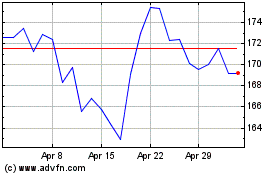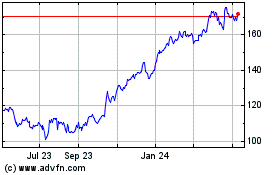Hurricane an Alarm for Insurers - Analyst Blog
May 27 2011 - 10:54AM
Zacks
The insurance industry continues to reel under significant
catastrophic losses incurred earlier this year. As if these weren’t
enough, threats related to the imminent hurricane season have
cropped up once again.
As many as 6 to 10 hurricanes have been forecast for the year by
The National Oceanic and Atmospheric Administration, 3 to 6 of
which is portended as grievous and major.
As a result, insurers could be knocked down by a huge gush of
insured losses, which could come crashing down on their capital
positions. In its annual hurricane season report published on
Thursday, Fitch Ratings forewarned that the insurance industry
could incur as much as $10 billion insured losses in the first half
of 2011.
This should ring alarm bells at major U.S. insurers including
Allstate Corp (ALL), Hartford Financial
Services Group Inc. (HIG), Lincoln National
Corp. (LNC) and Progressive Corp.
(PGR).
Fear Facts and Factors
Till now, this has been a stormy year for the insurers.
Earthquakes in Japan and New Zealand, flooding in Australia and
tornadoes in the Midwest and South in the United State have already
wreaked havoc. Many insurers have been forced to drain their 2011
catastrophe budget even before the hurricane season, which is
expected from June 1 to November 30.
The rating agency’s report said that the chance of hurricanes
hitting the Gulf Coast is 80% and that of Florida and East Coast is
81%. The statistics were figured out by Colorado State University
professors.
Though there were 19 storms in 2010, the damage was mild for the
U.S. However, the expected average hurricane for 2011 will smash
insurers’ already weak financial health.
The basic business of an insurance company is protecting its
policyholders against catastrophic or unintentional losses.
Insurance companies profit as a faction of its policyholders suffer
losses at a particular time, while its entire customer base must
necessarily pay premiums regularly. So the difference between
premium income from a large number of policyholders and claim
settlement only for a few of them is an insurer’s profit.
However, with atmospheric changes, including global warming and
thinning of ozone layer, chances of natural catastrophes are now
alarmingly high.
Braving the Storm
The general fear of natural disasters and consequent lose of
property or even life has pushed people to buy more insurance
policies. While this has lead to a surge in premium income, claim
rate has also increased tremendously.
Moreover, realizing the opportunities and problems, the insurers
are gradually increasing the prices of their products.
The fate of insurers will now depend on how well they manage to
counterbalance the money outflow due to the increasing number of
claims with money inflows from growing demand for insurance
policies and premium hike.
What Lies Ahead…
After enduring stress with respect to pricing pressure and
reduced insured exposure through mid 2009, the overall health of
the U.S. insurance industry has improved to some extent so far.
Though the market turmoil forced many companies to take immense
write-downs, the worst of the crisis appears to be now behind
us.
However, long lasting soft market conditions, shrinking businesses,
a still high unemployment rate and legislative challenges are
threatening insurers’ ability to rebound to the historical growth
rate. The industry will also continue to be challenged by rising
catastrophes such as the expected hurricane related losses luring
right around the corner.
ALLSTATE CORP (ALL): Free Stock Analysis Report
HARTFORD FIN SV (HIG): Free Stock Analysis Report
LINCOLN NATL-IN (LNC): Free Stock Analysis Report
PROGRESSIVE COR (PGR): Free Stock Analysis Report
Zacks Investment Research
Allstate (NYSE:ALL)
Historical Stock Chart
From Jun 2024 to Jul 2024

Allstate (NYSE:ALL)
Historical Stock Chart
From Jul 2023 to Jul 2024
